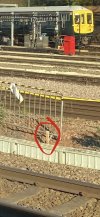That is certainly true. However, even before the structure spacings were increased, the tension was already higher in comparison to the ECML.
MML uses 12/15kN tensioning (12kN catenary, 15kN contact), independent of one another, north of Bedford.
South of Bedford it uses 11kN/11kN, shared on one balance weight that's supporting 22kN total.
(The whole ECML, pretty much, uses 11kN/11kN in the same way too.)
So already the OLE north of Bedford is more resilient than its ECML equivalent, and they didn't even experiment with ECML-esque structure spacing (circa 75m or so) until RS1 (Mkt H'boro - Wigston).
When the longer span publicity went out, it was one temporary span with a spare structure installed adjacent to return to after trial if needed.
Given it takes a combination of gust of wind, track tolerances, vehicle sway and some bad luck to cause a blow-off dewirement, I'm not sure what a one-year trial proves.
Back in the 1980s Margaret Thatcher demanding two 10% efficiencies on ECML electrification at approval of each phase. The Mark 3 design was robust, but when pressure increased on budget variables like "surrounding terrain" were stretched to fall in categories allowing longer spans. You can see the effect as you progress north!
It was this application of the rules that impacted performance rather than the system itself, with repeated dewirements in areas which with 20:20 hindsight should have fallen in the most exposed category.
The headspans don't affect risk of dewirement, but do affect time to restore traffic after one. That 20% cost saving was on a programme that was already being delivered for a tenth the cost of present UK electrification costs!
WCML electrification suffered similar blow-off dewirements in its early years, but money was found by BR to add additional structures in poor performing areas, which was never done on ECML, where "weather related speed restrictions" were successfully used to reduce vehicle sway and risk of dewirement on the existing infrastructure - at cost of reduced PPM. Of course the ECML problems became evident after privatisation and Railtrack had bigger capital spending problems on WCRM at the time, which was starting its journey to a 10x overspend.
The system hasn't changed significantly from an engineering perspective since then, but lower windspeed/terrain factors or tolerance of increased risk can allow longer spans to be installed in specific places, and the maximum span length limit in the rules has been raised to give more flexibility to designers.
Across Europe there are many off-the-shelf systems similar in design to UKMS, most of which use higher tensions than 11kN, but maximum span lengths are pretty similar across them all. Copper doesn't behave differently in British wind...


